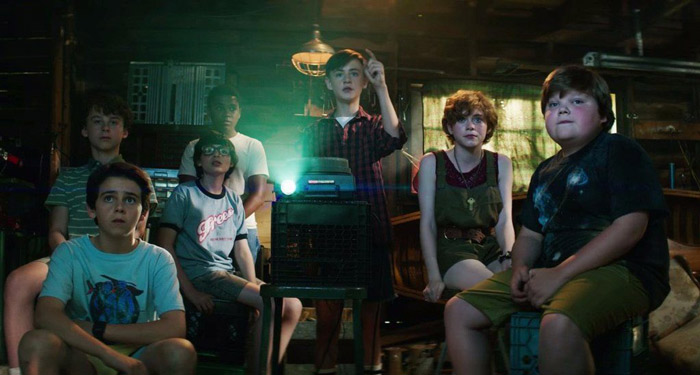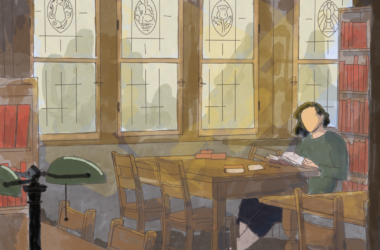It had been in “development hell” since 2009, cycling through a plethora of directors, writers, and stars. Based on the novel by Stephen King, and originally adapted into a 1990 miniseries, the feature film incarnation was finally released as the sophomore effort of director Andy Muschietti on Sept. 8. It is remarkable, then, that the finished product holds together as well as it does.
Muschietti is undoubtedly a cine-literate director. The bedrooms of the film’s middle schooler protagonists are plastered with posters of Beetlejuice (1988) and Gremlins (1984). Movie posters on local streets advertise A Nightmare on Elm Street 5 (1989). The film’s lengthy 135 minute runtime harkens back to the epic horror films of the 70s and 80s, such as The Exorcist (1973) and The Shining (1980)—films that, like It, were grounded in character and story before scares. Unlike the bold colors of the miniseries, the remake is washed in moody sepia tones, with a colour palette akin to Japanese horror classics such as Ringu or Dark Water. The film experiments with its stunning cinematography, including sweeping wide-shots and expertly-crafted mise-en-scene that would make Stanley Kubrick proud.
It will particularly resonate with fans of Stranger Things. The two projects share young star Finn Wolfhard (who plays protagonist Richie Tozier), and both make use of snappy dialogue from a central band of small-town misfits, coming-of-age angst, and staple images of riding bikes down suburban streets. In its contribution to the trend of 80s nostalgia, It takes on an almost self-aware quality, its world feeling more like a wistful time capsule than an actual period piece.
It’s strength lies in the movie’s young lead cast, particularly newcomers Sophia Lillis and Jack Dylan Grazer, who present some of the best child acting in recent memory. A witty script provides the backbone for lovable characters, and the actors give incredibly convincing portrayals of the genuine bonds within the motley crew of the “Losers Club.” The young cast works remarkably well with the film’s dark material, which ranges from sexual abuse, to racism, to grief.
Bill Skarsgard as Pennywise, the clown terrorizing the children, reimagines one of the most iconic roles in horror—portrayed by Tim Curry in the miniseries. Skarsgard gives a fantastic performance, albeit radically different from his predecessor. While Curry swings between wisecracking and vicious, Skarsgard is demonic. With yellow eyes, a misshapen infant-like head, and a cracking childish lilt of a voice, he ties in nightmare-nursery imagery throughout. He moves and dresses like a feral, decaying marionette. The inspirations for the costume, from Renaissance to Victorian, highlight the idea that Pennywise is from out of space and time.
When It focuses on the deeper implications behind what is terrorizing the children—namely, facing and coping with their respective traumas—it succeeds. In contrast to the classic Hollywood monsters used in the miniseries, Pennywise’s varying manifestations in the remake have a more timeless and psychoanalytical quality.
Sadly, it is primarily in its attempts at horror that It stumbles. In his book Danse Macabre, King lists three tactics used in horror: “The gross-out,” “the horror”—monsters, jump-scares—and “the terror,”—the bone-chilling, uncanny, and pervasive dread. It occasionally flirts with the gross-out, but mostly inhabits the horror. Only once does it reach the upper echelon of terror, in the first 15 minutes, during a flawless re-crafting of the classic gutter scene between Pennywise and Georgie. It is unfortunate that a director so ambitious in his filmmaking—and so clearly devoted to the genre—resorts to a seemingly endless conga line of jump-scares and haunted-house effects.
Moreover, while Muschietti manages to craft a darkly gorgeous phantasmagoria, he is overly reliant on CGI—much like in his 2013 debut, Mama. Pennywise’s character depiction is most haunting when he simply inhabits the frame, instead of flailing around in increasingly ridiculous spectacle. The constant barrage of fantastical imagery becomes tiring by the third act.
Perhaps It is a horror film for those who don’t like horror. Similar to Spielbergian horror-adventures like Poltergeist (1982), it has the characters and story to keep audiences emotionally engaged, and enough creepy imagery and textbook scares for the less genre-savvy without making them truly uncomfortable. However, for audiences who want to be haunted by a film long after the credits roll, It is best viewed as a subversive Stand By Me (1986), rather than as nightmare fuel.








